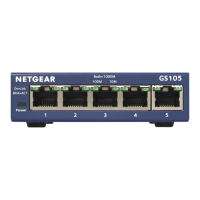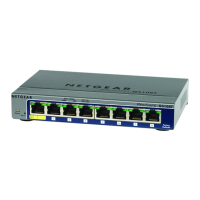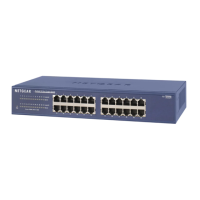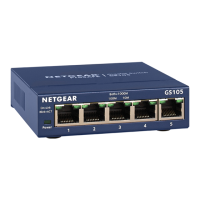Using the Command-Line Interface
15
ProSafe M4100 Series Managed Switches
Table 6 explains how to enter or exit each mode.
DHCPv6 Pool
Config
Switch (Config dhcp6-pool)# Contains the DHCPv6 server IPv6 address pool
configuration commands.
Stack Global
Config Mode
Switch (Config stack)# Allows you to access the Stack Global Config
Mode.
ARP Access-List
Config Mode
Switch (Config-arp-access-list)# Contains commands to add ARP ACL rules in
an ARP Access List.
Table 6. CLI Mode Access and Exit
Command Mode Access Method Exit or Access Previous Mode
User EXEC This is the first level of access. To exit, enter logout.
Privileged EXEC From the User EXEC mode, enter
enable.
To exit to the User EXEC mode, enter exit or
press Ctrl-Z.
Global Config From the Privileged EXEC mode,
enter configure.
To exit to the Privileged EXEC mode, enter exit,
or press Ctrl-Z.
VLAN Config From the Privileged EXEC mode,
enter vlan database.
To exit to the Privileged EXEC mode, enter exit,
or press Ctrl-Z.
Interface Config From the Global Config mode,
enter
interface <unit/slot/port>
or interface loopback <id>
or interface tunnel <id>
To exit to the Global Config mode, enter exit. To
return to the Privileged EXEC mode, enter
Ctrl-Z.
Line Config From the Global Config mode,
enter
lineconfig.
To exit to the Global Config mode, enter exit. To
return to the Privileged EXEC mode, enter
Ctrl-Z.
Policy-Map
Config
From the Global Config mode,
enter
policy-map <name> in.
To exit to the Global Config mode, enter exit. To
return to the Privileged EXEC mode, enter
Ctrl-Z.
Policy-Class-Map
Config
From the Policy Map mode enter
class.
To exit to the Policy Map mode, enter exit. To
return to the Privileged EXEC mode, enter
Ctrl-Z.
Class-Map
Config
From the Global Config mode,
enter
class-map, and specify the
optional keyword ipv4 to specify
the Layer 3 protocol for this class.
See class-map on page 466 for
more information.
To exit to the Global Config mode, enter exit. To
return to the Privileged EXEC mode, enter
Ctrl-Z.
Table 5. CLI Command Modes (Continued)
Command Mode Prompt Mode Description

